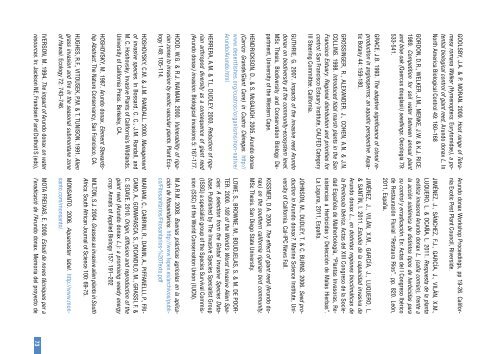Bases_para_el_manejo_y_control_de_Arundo_donax_tcm7-326547
Bases_para_el_manejo_y_control_de_Arundo_donax_tcm7-326547
Bases_para_el_manejo_y_control_de_Arundo_donax_tcm7-326547
Create successful ePaper yourself
Turn your PDF publications into a flip-book with our unique Google optimized e-Paper software.
GOOLSBY, J.A. & P. MORAN. 2009. Host range of Tetramesaromana Walker (Hymenoptera: Eurytomidae), a potentialbiological <strong>control</strong> of giant reed, <strong>Arundo</strong> <strong>donax</strong> L. InNorth America Biological Control 49: 160–168GORDON, D.R., WELKER, J.M., MENKE, J.W. & K.J. RICE.1989. Competition for soil water between annual plantand blue oak (Quercus douglasii) seedlings. Oecologia 79:533-541.GRACE, J.B. 1993. The adaptive significance of clonal reproductionin angiosperms: an aquatic perspective. AquaticBotany 44: 159-180.GROSSINGER, R., ALEXANDER, J., COHEN, A.N. & J.N.COLLINS. 1998. Introduced tidal marsh plants in the SanFrancisco Estuary. Regional distribution and priorities for<strong>control</strong>. San Francisco Estuary Institute, CALFED CategoryIII Steering Committee. California.GUTHRIE, G. 2007. Impacts of the invasive reed <strong>Arundo</strong><strong>donax</strong> on biodiversity at the community-ecosystem lev<strong>el</strong>.MSc Thesis, Biodiversity and Conservation Biology Department,University of the Western Cape.HENDRICKSON, D., & S. McGAUGH. 2005. <strong>Arundo</strong> <strong>donax</strong>(Carrizo Gran<strong>de</strong>/Giant Cane) in Cuatro Ciénegas. http://www.<strong>de</strong>sertfishes.org/cuatroc/organisms/non-native/<strong>Arundo</strong>/<strong>Arundo</strong>.htmlHERRERA, A.M. & T.L. DUDLEY. 2003. Reduction of riparianarthropod diversity as a consequence of giant reed(<strong>Arundo</strong> <strong>donax</strong>) invasion. Biological invasions 5: 167-177.<strong>Arundo</strong> <strong>donax</strong> Workshop Proceedings, pp 19-26. CaliforniaExotic Pest Plant Council, Riversi<strong>de</strong>.JIMÉNEZ, J., SÁNCHEZ, F.J., GARCÍA, J., VILÁN, X.M.,LUQUERO, L. & OCAÑA, L. 2011. Respuesta <strong>de</strong> la plantaexótica invasora <strong>Arundo</strong> <strong>donax</strong> L. (caña común), frente ala acción sistémica <strong>de</strong> distintos tipos <strong>de</strong> herbicidas <strong>para</strong>su <strong>control</strong> y erradicación. En: Actas d<strong>el</strong> I Congreso Ibérico<strong>de</strong> Restauración Fluvial “Restaura Ríos”. pp. 820. León,2011, España.JIMÉNEZ, J., VILÁN, X.M., GARCÍA, J., LUQUERO, L.& SANTÍN, I. 2011. Estudio <strong>de</strong> la capacidad invasiva <strong>de</strong><strong>Arundo</strong> <strong>donax</strong> L., en distintas regiones bioclimáticas d<strong>el</strong>a Península Ibérica. Actas d<strong>el</strong> XIII Congreso <strong>de</strong> la SociedadEspañola <strong>de</strong> Malherbología, “Plantas Invasoras, Resistenciasa Herbicidas y Detección <strong>de</strong> Malas Hierbas”.La Laguna, 2011, España.JOHNSON, M., DUDLEY, T. & C. BURNS. 2006. Seed productionin <strong>Arundo</strong> <strong>donax</strong>?. Marine Science Institute, Universityof California. Cal-IPC News Fall.KISSNER, D.A. 2004. The effect of giant reed (<strong>Arundo</strong> <strong>donax</strong>)on the southern california riparian bird community.MSc Thesis. San Diego State University.LOWE, S., BROWNE, M., BOUDJELAS, S. & M. DE POOR-TER. 2000. 100 of the World’s Worst Invasive Alien Species:A s<strong>el</strong>ection from the Global Invasive Species Database.Published by The Invasive Species Specialist Group(ISSG) a specialist group of the Species Survival Commission(SSC) of the World Conservation Union (IUCN).HOOD, W.G. & R.J. NAIMAN. 2000. Vulnerability of riparianzones to invasion by exotic vascular plants. Plant Ecology148: 105-114.M.A.R.M. 2008. Buenas prácticas agrícolas en la aplicación<strong>de</strong> fitosanitarios. http://www.fepex.es/archivos/publico/Fitosanitarios/Fitosantarios-%20Texto.pdfHOSHOVSKY, C.M. & J.M. RANDALL. 2000. Managementof invasive species. In Bossard, C. C., J.M. Randall, andM. C. Hoshovsky. Invasive Plants of California’s Wildlands.University of California Press. Berk<strong>el</strong>ey, CA.HOSHOVSKY, M. 1987. <strong>Arundo</strong> <strong>donax</strong>. Element StewardshipAbstract. The Nature Conservancy, San Francisco, CA.HUGHES, R.F., VITOUSEK, P.M. & T. TUNISON. 1991. Aliengrass invasion and fire in the seasonal submontane zoneof Hawaii. Ecology 72: 743–746.MARIANI, C., CABRINI, R., DANIN, A., PIFFANELLI, P., FRI-CANO, A., GOMARASCA, S., DICANDILO, M., GRASSI, F. &C. SOAVE. 2010. Origin, diffusion and reproduction of thegiant reed (<strong>Arundo</strong> <strong>donax</strong> L.): a promising weedy energycrop. Annals of Applied Biology 157: 191–202MILTON, S.J. 2004. Grasses as invasive alien plants in SouthAfrica. South African Journal of Science 100: 69-75.MONSANTO. 2006. Aquamaster lab<strong>el</strong>. http://www.monsanto.com/monsanto/.IVERSON, M. 1994. The impact of <strong>Arundo</strong> <strong>donax</strong> on waterresources. In: Jackson NE, Frandsen P and Duthoit S (eds),MOTA FREIXAS, E. 2009. Estudi <strong>de</strong> noves tècniques per al’eradicació <strong>de</strong> l’<strong>Arundo</strong> <strong>donax</strong>. Memoria d<strong>el</strong> proyecto <strong>de</strong>73


